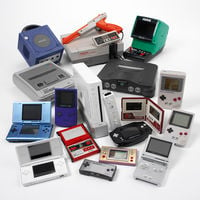Nintendo
- This article is about the Japanese company. For the console sometimes colloquially referred to as a Nintendo, see Nintendo Entertainment System. For the development team, see Nintendo Entertainment Planning and Development.
| Nintendo | |
|---|---|

| |
| Founded | September 23, 1889[?] |
| First Super Mario game | Donkey Kong (1981) |
| Latest Super Mario game | Nintendo World Championships: NES Edition (2024) |
| Current president | Shuntaro Furukawa |
Nintendo is a Japanese video game company and the creator of many popular franchises, including the Super Mario franchise, and the company's mascot is Mario himself.
History
Originally founded as a hanafuda playing card manufacturer in Kyoto, Japan, on September 23, 1889, Nintendo began exploring game-making after third president Hiroshi Yamauchi began diversifying the company's ventures. Nintendo entered the arcade industry in 1973 and the home console industry in 1977, simultaneously hiring Shigeru Miyamoto as a product designer. In 1978, Nintendo began making arcade video games, licensing titles to other companies for distribution outside Japan. In 1980, Nintendo established a North American division headed by Minoru Arakawa, and the first game that would be distributed by the American division would be Radar Scope. The game did not sell well in the United States, and a number of unsold cabinets remained in warehouses.
Arakawa asked Yamauchi if a new game could be developed and inserted into the unsold Radar Scope cabinets.[1] Yamauchi went through Nintendo's entire talent pool to see who could head the designing of a potential Radar Scope replacement, and the result was Miyamoto designing Donkey Kong. When Donkey Kong was released in 1981, it became a bestseller and marked the introduction of Mario. In 1983, Nintendo introduced the Family Computer, distributing it abroad as the Nintendo Entertainment System two years later. Its success in Japan and North America resulted in Nintendo becoming a dominant player in the video game industry and the revival of the industry in North America, which had been negatively affected by a crash in 1983. The most successful game for the NES, Super Mario Bros., further cemented Nintendo's dominance in the industry. The Super Mario franchise has since become Nintendo's flagship franchise and one of the most well-known brands to originate from video games.
Supported regions
As a multinational company, Nintendo has established various regional divisions dedicated to marketing and sales of its products outside Japan, including Super Mario games, merchandise, and licensing, located in different gaming markets around the world, and all of them are wholly owned. Two major subsidiaries, Nintendo of America and Nintendo of Europe, have the authority to publish games autonomously. As of August 2024, these divisions include:
- Nintendo Co., Ltd. (NCL)
- Nintendo of America, Inc. (NOA)
- Nintendo of Europe SE (NOE)
- Nintendo Australia Pty. Limited (NAL)
- Nintendo of Korea Co., Ltd. (NOK)
- Nintendo (Hong Kong) Ltd. (NHK)
In addition to the above subsidiaries, over the years Nintendo has officially assigned various third-party distribution companies to represent Nintendo and its products (including Super Mario products) in certain markets. These partners may have the authority to handle marketing and sales, but they may vary and are overviewed by one of the three major divisions (NCL, NOA, NOE). As of September 2023, the following partners include:
- Active Bokei K.K.[2]
- Advanced Initiative Company Trading[3]
- Bergsala AB[4][5]
- CD Media S.E.[6][7]
- ConQuest Entertainment A.S.
- Tencent[8]
- TorGaming, Ltd.[9]
Appearances in the Super Mario universe
- The WarioWare character 9-Volt calls himself "Nintendo's biggest fanboy," and his microgames are based on or around various Nintendo games and systems such as Dr. Mario and Donkey Kong.
- Diddy Kong's red cap has the Nintendo logo on it.
- Nintendo sponsors can be seen in the background of various Mario Kart courses and battle arenas.
- In the Mario Party series, the Nintendo logo, along with the Hudson Soft logo, appears on banners in various minigames.
- In Donkey Kong 64, Nintendo, along with Rareware, sponsors the boxing match between the Kongs and King K. Rool as mentioned by the Microphone.
- In Mario Power Tennis, the Nintendo logo appears on the Peach Dome court.
- In Mario Golf: Toadstool Tour and Mario Power Tennis, Wario holds up the Nintendo sign when the game boots up while stating the company's name, laughing.
- In Mario Hoops 3-on-3, the Nintendo logo, along with the Square Enix logo, appears on the arch next to the basket at Peach Field and on the banner and a large screen on the Mario Stadium court.
- In the Mario Baseball series, the Nintendo logo appears on some signs in Mario Stadium.
- In Mario Sports Mix, the Nintendo logo appears next to the sports equipment on the banners in Mario Stadium.
- In Mario Tennis Open, the Nintendo logo can be seen on the scoreboards in various courts.
Home consoles
- Color TV-Game series (1977–1982)
- Family Computer (1983–2003) / Nintendo Entertainment System (1985–1995)
- Super Famicom (1990–2003) / Super Nintendo Entertainment System (1991–1999)
- Nintendo 64 (1996–2003)
- Nintendo GameCube (2001–2009)
- Wii (2006–2013)
- Wii U (2012–2017)
- Nintendo Switch1 (2017–present)
Attachments and remodels
- Family Computer Disk System (1986–1994)
- Satellaview (1995–2000)
- Nintendo 64DD (1999–2001)
- Wii Family Edition (2011–2013)
- Wii mini (2012–2017)
These consoles may have different names in different markets. The NES is known as the Family Computer (or Famicom) in Japan; the Super NES, subsequently as the Super Famicom. In 2003, a plug-in gamepad device called the iQue Player was released exclusively in China, and in simple terms, it is considered a variant of the Nintendo 64.
1 - Although the Nintendo Switch can also function as a handheld console, it is primarily marketed as a home console by Nintendo.
Handheld consoles
- Game & Watch (1980–1991)
- Game Boy (1989–2003)
- Virtual Boy (1995–1996)
- Game Boy Color (1998–2003)
- Game Boy Advance (2001–2009)
- Nintendo DS (2004–2013)
- Nintendo 3DS (2011–2019)
Remodels
- Game Boy Play It Loud (1996)
- Game Boy Pocket (1996–1998)
- Game Boy Light (1997–2003)
- Game Boy Advance SP (2003–2009)
- Game Boy Micro (2005–2009)
- Nintendo DS Lite (2006–2011)
- Nintendo DSi (2008–2013)
- Nintendo DSi XL (2009–2013)
- Nintendo 3DS XL (2012–2015)
- Nintendo 2DS (2013–2020)
- New Nintendo 3DS (2014–2017)
- New Nintendo 3DS XL (2014–2019)
- New Nintendo 2DS XL (2017–2020)
- Nintendo Switch Lite (2019–present)
Between 2004 and 2018, Nintendo authorized the release of some of its portable consoles in the mainland Chinese market under the "iQue" brand. For example, the Nintendo DS and the Nintendo 3DS XL are referred to as the iQue DS and the iQue 3DS XL, respectively, in China.
Gallery
The gold Nintendo logo from the start-up of Mario Kart 64
Sprite of a Nintendo logo variant, from Diddy Kong Racing DS
The white Nintendo logo in a black background as seen in the first three Mario Party titles
The Nintendo logo recreated in the Super Mario Bros. game style in Super Mario Maker
Background featuring characters of the Super Mario franchise created by Nintendo
Artwork of Nintendo's Kyoto headquarters from its recruitment book, showing a Warp Pipe at the bottom left corner
See also
- Shigeru Miyamoto
- Satoru Iwata
- Hiroshi Yamauchi
- Yoshiaki Koizumi
- Tatsumi Kimishima
- Koji Kondo
- Gunpei Yokoi
- Reggie Fils-Aimé
- Doug Bowser
Names in other languages
| Language | Name | Meaning | Notes |
|---|---|---|---|
| Japanese | 任天堂 Nintendō |
The formal name of the company; in hiragana it is written as 「にんてんどう」, two kanas or moras per kanji. Each of the kanji that make up its formal name means the following:
|
This name comes from the Japanese saying 「運を天に任せる」 (un o ten ni makaseru), meaning "to leave one's luck to heaven." Consequently, Nintendo officially translates its name as "Leave Luck to Heaven." However, the historical validity of this is disputed, as the kanji for "Nintendo" can be translated in multiple other ways (e.g., "Temple of Free Hanafuda," referencing the company's origins as a playing card company); late president Hiroshi Yamauchi admitted in The History of Nintendo that he did not actually know what "Nintendo" meant, stating that the official translation was accepted by the company only because it sounded like "a plausible explanation."[10] |
| ニンテンドー[?] Nintendō |
Rough katakana form used for the Japanese names of some consoles. | ||
| ニンテンドウ[?] Nintendō |
Rough katakana form, written with the kana "u" (ウ) instead of the long sound symbol (ー). | Used only in Super Smash Bros.'s Japanese name. | |
| Arabic | نينتندو[11] Nintendo |
- | |
| Chinese | 任天堂[?] Rèntiāntáng |
- | |
| Finnish | Nintendon[?] | - | Captain N: The Game Master |
| Nintendo[?] | |||
| Greek | Νιντέντο[?] Ninténto |
- | |
| Hebrew | נינטנדו[?] Nintendo |
- | |
| Korean | 닌텐도[?] Nintendo |
- | |
| Russian | Нинтендо[?] Nintendo |
- |
References
- ^ "IGN Presents: The History of Super Mario Bros."
- ^ Active Bokei K.K.. Active Bokei K.K. (English). Retrieved July 3, 2024. (Archived June 3, 2024, 05:14:24 UTC via Wayback Machine.)
- ^ Advanced Initiative. Advanced Initiative Co. Trdg. (English). Retrieved July 4, 2024.
- ^ Joe Skrebels (December 9, 2019). The Lie That Helped Build Nintendo. IGN (English). Retrieved June 1, 2024. (Archived December 21, 2019, 23:17:14 UTC via Wayback Machine.)
- ^ Home. Bergsala (English). Retrieved September 26, 2024. (Archived June 14, 2024, 01:43:01 UTC via Wayback Machine.)
- ^ Enes K. (July 24, 2018). Resmi Açıklama Geldi: Nintendo Switch Türkiye'de Satışa Çıkıyor. Webtekno (Turkish). Retrieved June 5, 2024. (Archived October 17, 2018, 00:20:49 UTC via Wayback Machine.)
- ^ Partnerships. CD Media S.E. (English). Retrieved July 3, 2024. (Archived March 29, 2023, 11:50:20 UTC via Wayback Machine.)
- ^ Takashi Moshizuki, Shan Li (April 18, 2019). Nintendo, With Tencent's Help, to Sell Switch Console in China. The Wall Street Journal (English). Retrieved July 3, 2024. (Archived December 6, 2019, 20:13:54 UTC via Wayback Machine.)
- ^ March 12, 2019. לראשונה בישראל – תור גיימינג משיקה את נינטנדו בארץ ביבוא רשמ. IGN Israel (Hebrew). Retrieved June 5, 2024. (Archived May 15, 2019, 03:34:09 UTC via Wayback Machine.)
- ^ Brian Ashcraft (August 3, 2017). "Nintendo" Probably Doesn't Mean What You Think It Does. Kotaku (English). Retrieved September 16, 2024. (Archived August 19, 2024, 11:55:47 UTC via Wayback Machine.)
- ^ نينتندو السعودية (الممثل الرسمي). X (Arabic). Retrieved July 6, 2024.
External links
- Official Japan website
- Official United States website
- Official Canada (English) website
- Official Canada (French) website
- Official UK & Ireland website
- Official Mexico website
- Official Brazil website
- Official Colombia website
- Official Argentina website
- Official Chile website
- Official Peru website
- Official Europe website
- Official Denmark website
- Official Finland website
- Official Norway website
- Official Sweden website
- Official Hungary website
- Official Poland website
- Official Czechia website
- Official Slovakia website
- Official Israeli website
- Official U.A.E. website
- Official Saudi website
- Official Oceania website
- Official South Korea website
- Official Hong Kong website
- Official Taiwan website
- Official Singapore website
- Official Malaysia website
- Official Philippines website
- Official Thailand website
- Official South Africa website
- Official mainland China website
- Official Greek website
- Official Croatian website
- Official Bulgarian website
- Official Slovenian website
- Official Romanian website
- Official Serbian website




